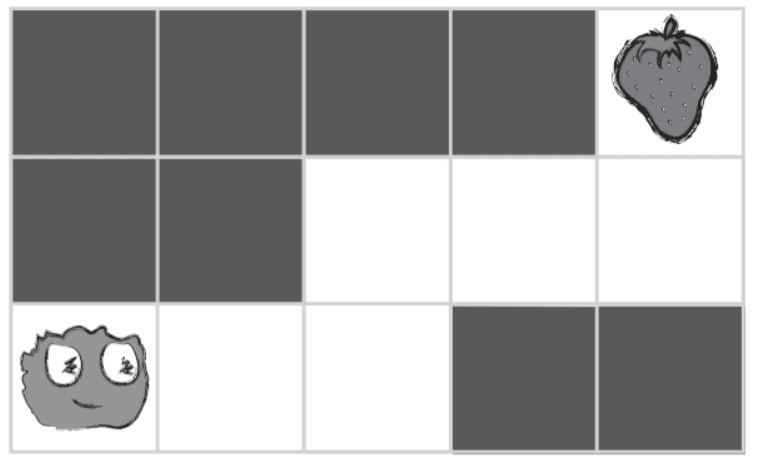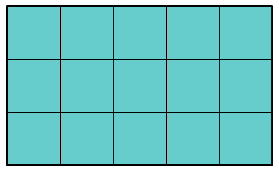and Perimeter
What is coding?
Coding is a set of instructions that we create to communicate with computers.
What does it mean when we say two shapes are "congruent"?
Congruent shapes have the same size and shape. This means that the side lengths and angles are the same.

What are the four main units that we use to measure distances?
Give an example of something you would measure using each.
Millimetre (mm) - Small distance, like the length of an eraser
Centimetre (cm) - Small/medium distance, like the length of your hand
Metre (m) - Medium/long distance, like the length of our classroom
Kilometre (km) - Long distance, like the distance you drive across Ontario
What is mass and how can we accurately measure it?
Mass is the amount of matter in an object. Objects with more mass have more weight.
We can use a pan balance to measure the mass of an object.
When you are asked to round a number to the nearest 10, how do you know whether to round down or up?
When rounding to the nearest 10, we look at the last number.
If the number ends in a 0, 1, 2, 3 or 4, you always round down.
If the number ends in a 5, 6, 7, 8 or 9, you always round up.

Which of the following codes will get the mouse to the delicious cheese?

Option 2 will get the mouse to the delicious cheese.
Which two 3D shapes are congruent? Explain how you know.
A.  B.
B. C.
C.  D.
D.
Shapes A and C are congruent. They are both cubes, and are the exact same size and shape.
Shape B and Shape D are both rectangular prisms. One is very long and one is shorter than the rest.
What is the length of the object shown below? Explain how you would accurately measure this object using a ruler.

To measure using a ruler, we must line up the object exactly at the the 0cm mark of the ruler. We then look to see what line is closest to where the object ends.
In this picture, the length of the object is 14cm.
Looking at the pan balance, which object has more mass? How do you know?

The apple has more mass than the carrot. We know because the pan balance is tilting in the direction of the apple.
Round the following number to the nearest 10:
64
64 is in between 60 and 70. Since the original number ends in a 4, we know that we must round down.
The answer is 60.
What is debugging? Can you debug the following code:



![]()

![]()
Debugging is when you find an issue in the program that you have written and repair it.
We did not go far enough to the right, so we bumped into the wall. The correct code is:


![]()


![]()
What is area?
Area is the amount of surface or space inside of a shape.
For example, the area of this shape is 7cm squared.

What is perimeter?
Perimeter is the distance around a shape. We can find perimeter by counting or adding up all of the side lengths.

Which object has more mass? How do you know?


The book has more mass. We know because if we held a book in one hand and a pencil in the other, we could feel that the book is heavier and has more mass. If we put the two items in a pan balance, it would tilt in the direction of the book.
Round the following number to the nearest 10:
736
736 is in between 730 and 740. Since the original number ends in a 6, we know that we must round up.
The answer is 740.
What is the ratio of flowers to hearts?
❁ ❁ ♡ ♡ ♡ ♡ ♡ ♡ ♡
The ratio of flowers to hearts is 2:7. We know this because there are 2 flowers and 7 hearts shown.
What is the area of this shape? How do you know?
The area of this shape is 14cm squared. We can count up all of the square units to find our total answer.
What is the perimeter of this shape? How do you know?

The perimeter of this rectangle is 28cm. We can add all of the side lengths together to find the answer.
10 + 10 = 20cm
4 + 4 = 8cm
20 + 8 = 28cm
What is capacity?
Capacity is how much liquid/solids a container can hold.
When you are asked to round a number to the nearest 100, how do you know whether to round down or up?
When rounding to the nearest 100, we look at the number in the tens column.
If the number in the tens column is 0, 1, 2, 3 or 4, you always round down.
If the number in the tens column is 5, 6, 7, 8 or 9, you always round up.
△ ∎ ∎ ∎ ∎ ∎
The ratio of triangles to squares is ___ : ___.
If you had 5 triangles, how many squares would you have?
The ratio of triangles to squares is 1:5.
If you had 5 triangles, you would have 25 squares.
We can take the original ratio 1:5 and multiply both numbers by 5 to find out how many triangles and how many squares there would be.
What is the area of this shape? How do you know?

The area of this shape is 15cm squared. We can count up all of the square units to find our total answer.
We could also do 5 + 5 + 5 OR we could do 3 x 5. There are 3 rows with 5 squares in each.
5 + 5 + 5 = 15
3 x 5 = 15
How could you find the perimeter of a curved shape like the one seen below? Why do we measure this way?

We can find the perimeter of curved shapes by using string. We can use the string to find the length of the shape. Then we measure the length of the string with a ruler to find the perimeter.
A ruler can only measure straight lines, so we use string first because it is flexible and can bend around the shape nicely.
Which container has the largest capacity? Which container has the smallest capacity? How do you know?



The container with the largest capacity is the large pot. It is a very tall and wide container, and it would hold the most amount of liquid.
The container with the smallest capacity is the mug. It is the smallest and shortest container, and it would hold the least amount of liquid.
Round the following number to the nearest 100:
452
We know that 452 is between 400 and 500. Since the number in the tens column is 5, we know that we must round up.
The answer is 500.
